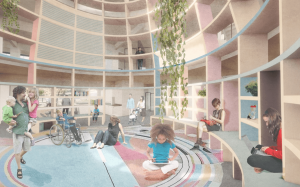A live mental health ward is an extremely challenging environment to manage a construction project. In our latest blog, Procure Partnerships Director, Robbie Blackhurst, discusses the challenges associated with maintaining a positive, healing environment which supports recovery, whilst successfully delivering capital projects in mental health facilities.
Many studies have proven that the quality of the healthcare environment has significant implications on a service user’s recovery. Service users are sensitive to their architectural environment and appear to make significantly better progress in newer, purpose-designed buildings rather than in older, out-dated facilities. Studies have found that in the purpose-built mental health facilities, service user recovery times were reduced by up to 14% and the number of serious cases of verbal abuse and threatening behaviour were significantly reduced.
The importance of the hospital environment and its contributory effect to a service user’s sense of wellbeing cannot be underestimated. Capital projects to upgrade and refurbish mental health facilities are an important way to bring older buildings in line with the modern mental health design philosophies. New mental health facilities are designed to support recovery, helping to facilitate the human interactions essential to treatment and also meet service user’s basic needs for safety, security and wellbeing.
Maintaining a Positive Environment During Construction Works
The provision of a supportive and safe environment which protects the service user’s sense of dignity and privacy during treatment, is the fundamental objective of mental health facilities. Given the important role that the hospital environment can have in the treatment and recovery of service user’s, the actual process of undertaking refurbishment and upgrade projects within live mental health facilities needs specific consideration and management in order to maintain a positive environment throughout the works.
With construction work comes noise, dust and disruption, all of which have the potential to hinder service user experience and negatively influence their environment. With this in mind, what considerations do the construction delivery team need to make in order to support the healing environment throughout the project?
1. Support Continuity of Care
The ability for the healthcare team to provide consistent care for service user’s must remain a priority throughout the construction works. An understanding of the healthcare facility and its critical operations is essential in understanding how the construction works may impact the facility. Maybe some areas need to remain quiet during treatment times, or it is important for specific entrance and exit points to be maintained at all times. By building early relationships with the healthcare teams, the construction team can develop an understanding of what important systems need to be maintained early in the planning process. Early engagement will also benefit the contractor, helping to prevent unexpected delays to construction progress. The appointment of a designated liaison representative from each member of the project team can help to facilitate daily communication and efficiently deal with issues as they arise.
2. Maintain Security
Service user security is a critical concern in mental health facilities. There are often sophisticated security arrangements which could cause dangerous health and safety implications if breached. A traditional construction site would have many different suppliers, supply chain partners and material deliveries attending site daily. In a live hospital environment, all visits to site must be controlled and managed to maintain security. When working closely to vulnerable service user’s, all member of the construction team and supply chain need to have a firm understanding of the security implications and the code of conduct required. Regular security briefings are essential in reinforcing key security messages. Often, main contractors develop long-term, trusted relationships with key suppliers and subcontractors who understand the environment, allowing them to provide additional reassurance to the healthcare teams.
3. Promote Health and Safety
Working in close proximity to operational facilities means the health and safety of service user’s and hospital staff must be considered at every stage. Construction work can often be unpredictable and there is always potential for change. Effectively controlling these activities to eliminate risk whilst still ensuing the project progresses as necessary is a major challenge when working in a live mental health environment. Risk must be assessed on a daily basis in conjunction with the hospital staff and continuous communication with the healthcare staff must be maintained. The secure segregation of construction works from the live ward is essential to effectively manage safety and the contractor must lead the way in developing an effective logistics plan which will result in the least disruption to the ward.
4. Flexible Programme Management
There is a fine balance to be struck between achieving critical programme milestones and also working flexibly to accommodate the requirements of the healthcare professionals and service user’s. Thinks can change quickly in a live mental health environment and emergency situations can arise without warning. There may often be a requirement to temporarily suspend works or change the works scheduled for that day in order to accommodate the needs of the ward. The ability to flexibly adapt to the needs of service user’s and work out of sequence is critical, for example, stopping work during service user exercise times.
5. Promote Service User Wellbeing
The construction team should always be looking for opportunities to promote service user wellbeing and to improve their experience whilst the construction works are taking place. An understanding of service user care will allow the construction managers to consider opportunities to add value during the planning stages, for example prioritising the early completion of critical spaces, such as outdoor areas or communal areas to benefit the service user’s and support their wellbeing. Developing relationships with the healthcare professionals as the project progresses means more opportunities to support the overall vision and objectives of the healthcare unit may be identified.
There is often a requirement for the construction team to contribute to stakeholder and service user engagement activities, which can help deliver a ‘service led’ approach to the construction works. Working collaboratively with the healthcare teams to support engagement activities, or community projects is an important way to leverage additional value from the construction works to benefit the overall facility.



